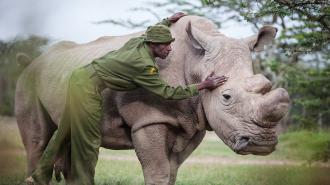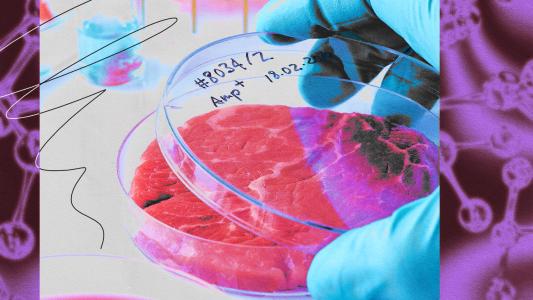The northern white rhinoceros is doomed to extinction. All traces of the subspecies vanished from the wild in 2007 — likely the victims of poachers. The last remaining male, Sudan, died in captivity in 2018, leaving only his daughter, Najin, and his granddaughter, Fatu, as the last surviving members. Both live under 24-hour protective custody at Ol Pejeta Conservancy, Kenya. However, health complications prevent either from carrying a calf to term.
Such dire circumstances mean that traditional conservation strategies, such as habitat protection or off-site breeding programs, are no longer viable options for saving the species. In a few short decades, we’ll witness the end of an evolutionary lineage millions of years in the making.
It’s a man-made tragedy that we’ve written hundreds of times before. But an international consortium of scientists and conservation organizations is working to ensure that extinction isn’t the end of the northern white rhinoceros’ story. Under the project name BioRescue, they hope to use advanced technologies to resurrect and repopulate the subspecies.
A roadmap for resurrection
BioRescue began at a 2015 meeting of scientists workshopping options to save the northern white rhino. From that meeting, they sketched out a roadmap for three objectives. The first objective was to develop and refine the procedures necessary to produce new northern white rhino offspring. But with no living member capable of reproducing, the team would need to create its own path to reproduction with novel technologies.
To that end, the consortium began collecting eggs from Najin and Fatu to be matured and fertilized into viable embryos. Since 2019, a team of veterinarians and conservationists has collected eggs on 13 separate occasions, and from those collections, they have managed to successfully fertilize 29. These fertilized embryos are currently cryopreserved in liquid nitrogen at the Avantea laboratory in Cremona, Italy.

While this represents a major step toward that first objective, it also demonstrates one of the major hurdles to the northern white rhino’s survival: scarcity.
For the animals’ safety, the egg collection can only be carried out a few times a year, and due to Najin’s age, it was decided she would no longer undergo the procedure. This leaves Fatu as the subspecies’ last living donor.
Additionally, the 29 viable embryos collected so far came from a stock of more than 100 harvested eggs.
Such scarcity also leads to concerns over inbreeding. Currently, BioRescue uses preserved semen from four deceased northern white rhinos to fertilize the eggs. However, so few genetic lines increases the risk of heritable disorders. To promote genetic diversity and build resilience in future populations, the consortium is looking toward another advanced reproductive technology: the artificial creation of reproductive cells.
Cryobanks at the San Diego Zoo and the Leibniz Institute for Zoo and Wildlife Research house ordinary tissue cells from other northern white rhinos. Scientists are using those regular adult cells to generate pluripotent stem cells — that is, cells reprogrammed back into an embryonic-like state. They then hope to transform these stem cells into artificial reproductive cells. If successful, it would add several new genetic lines for scientists to work with and also ease the scarcity of resources for future experiments.
“Every step of this mission is uncharted scientific territory, and the limited availability of oocytes and the low genetic diversity of the represented population are a particular challenge,” Thomas Hildebrandt, a BioRescue project leader and head of the Department of Reproduction Management at Leibniz, said in a press release.
Every step of this mission is uncharted scientific territory.
Thomas Hildebrandt
The search for surrogacy
Even if those hurdles are overcome, there is still one more to clear: Scientists must develop an in vitro fertilization (IVF) technique to birth a baby rhino.
“The stem cell approach is a hugely important piece of the puzzle for our mission, but it does not exempt us from having to master challenging steps such as embryo transfer and thus creating a pregnancy in a surrogate mother,” Hildebrandt added.
No rhinos have been born using IVF so far. Several attempts have been conducted at European zoos, but none have succeeded. That’s because every species represents its own unique challenges to getting the procedure and technologies correct. For example, the laparoscopic transfer performed routinely on domestic animals, such as sheep, is difficult for rhinos because of the “thickness of their skin, difficulty to control intra-abdominal pressure, and highly restricted wound healing-management.”

As such, BioRescue will have to test any procedure with a southern white rhino first. If that proves the IVF technique can work, the next step would be to transfer a northern white rhino embryo to a surrogate southern white mother.
Even here, unknowns await. While the northern and southern white rhinos are classified as subspecies of the same species, there are important physiological differences between the two. Some taxonomists even argue that they are physically and genetically distinct enough to be considered two separate species. It therefore remains an open question whether a southern white rhino can carry a northern white rhino calf to term.
Out of the lab, into the wild
That’s a lot of challenges to overcome, and success here only gets us past the first objective. If scientists can birth a northern white rhino calf, the next steps would be to increase the population and then create a recovery program for a healthy, self-sustaining population.
But as the project moves from the lab and into the wild, these challenges become mired in even more fraught ethical concerns*. Some critics argue that resurrecting extinct species takes time, attention, and resources away from other endangered animals that could still be saved with conservation.
Additionally, even if the roadmap proves successful, there is the question of what to do with a resurrected population of northern white rhinos. BioRescue’s endgame is the reintroduction of the subspecies into its natural habitat.
As noted on the project’s website: “Ultimately, the value of these animals can only be realized if they are reintroduced to the wild. Their genes can then be expressed in the environments in which they were evolved and so strengthen the white rhino’s chance of survival. The subspecies also plays an important role as a large herbivore in its native ecosystems.”
However, the pressures that drove the subspecies to extinction have not abated. Poaching still endangers every rhino species as demand for their horns remains high in markets like China and Vietnam. If these conditions don’t change, any population would have to remain in captivity for their safety.
Biobanking on the future
History offers hope, though. In the late 19th century, the southern white rhino was actually thought to be extinct — the result of the colonial era’s trophy-hunting craze, as well as habitat loss due to agricultural and settlement sprawl. But a small population survived, and after a century of conservation management, those last few rhinos grew into a population 18,000 strong. Today, the southern white rhino is the only rhino species not considered endangered.
Even if the fate of the northern white rhino is written, the technologies and procedures developed by BioRescue may prove critical for returning other species from the brink. According to a United Nations intergovernmental report, more than a million plant and animal species are threatened with extinction in the coming decades. Technologies that allow us to save biological samples for future reintroduction may be the only safety net some of these species and ecosystems have — though, it’s a safety net best to never need.
* Author’s Note: BioRescue is monitored and evaluated by the Ethics Laboratory for Veterinary Medicine, Conservation, and Animal Welfare at Padua University, Italy.






